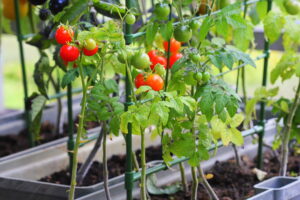Growing Herbs Indoors

Now that winter is around the corner, you may think the time for fresh home-grown produce is over. But lucky for you—and your taste buds—growing herbs indoors is not only possible, it’s easy—under the right conditions. Learn how to grow herbs inside so you can enjoy fresh, fragrant plants all year long.
Why You Should Grow Herbs Indoors
Winter weather doesn’t have to be the only reason for setting up an indoor garden. Here are some additional benefits:
- Extend garden space
- Add greenery to your decor
- Fresh produce at your fingertips
- Save money on expensive or wasted food
- Low maintenance and stakes
Imagine finding a recipe that calls for fresh mint. Instead of running to the store and paying for more than you need, you can simply snip what the recipe calls for. If you happen to clip too much, wrap extras in a damp paper towel and store it in a resealable bag for later.
In order to take full advantage of these benefits, you need to set up the right plants for success, preferably in a sunny spot.
Picking Herbs for Indoor Gardening
Most herbs can be grown indoors, but some thrive better than others, including:
- Basil
- Chives
- Mint
- Oregano
- Parsley
- Rosemary
- Thyme
- Cilantro
You can grow these plants from seed or seedlings from a nursery. Starting seeds is easily done indoors under a grow light or by a sunny window. If you already have these plants in an outdoor garden, you can also propagate another plant with the following process:
- Clip a branch off at the node of the existing plant.
- Soak it in water.
- Wait for new roots to sprout before planting.
Once you know which herbs you want to grow, it’s time to find it the right home.
The Ideal Indoor Gardening Setup
When you choose to plant indoors, you have a lot more control over the amount of light, water, and nutrients a plant gets. Here are some tips on how to provide your plants with the optimal indoor environment
Light
Herbs prefer a lot of light. Make sure your indoor herb garden gets at least six hours of sun per day. Consider rotating the pots for even exposure. If you want to fill your south-facing window sill with a wide variety of herbs, you need the right pots.
Container
The key to herb plant health lies in its container (literally—the potting soil, plant roots, and edible elements are all contained in this essential space). While there may be a variety of herb pot designs, you can use any container as long it has proper drainage. This ensures the plant roots aren’t rotting in too much water. Smaller herbs need less space. But keep in mind that the larger the container, the more herbs you’ll get. Consider placing a saucer underneath the pot to protect whatever surface it’s on.
Soil
Use a well-draining potting mix formulated for herbs or vegetables. You can add your own organic mixture along with aerating minerals, like perlite. Avoid using garden soil, which may compact and hinder root growth. Fertilize sparingly, since too much can lead to lush foliage with diminished flavor.
Water
Little plants in tiny pots don’t need a lot of water, but they still need enough attention to make sure they don’t dry up too quickly. Keep the soil consistently moist, but not waterlogged. Water when the top inch of soil feels dry. If the leaves begin to yellow or wilt, scale back the moisture. Herbs also prefer humid conditions, so you can consider placing a tray of water near the plants or misting them in the winter.
Maintenance
Herbs still need to get pruned regularly for optimal growth. You’ll also want to replace some periodically, as cilantro and basil may lose flavor over time.
Even though you’re not outdoors, an indoor herb garden is still susceptible to pest infestations. Regularly check for aphids or spider mites and use a little neem oil if needed.
Under the right conditions, you’ll have a productive indoor herb garden to help enhance your space and recipes in no time.
Harvesting Your Herb Garden
The great thing about growing herbs inside is that you have fresh produce at the ready when you need it. You can clip a few sprigs with shears or your fingers. Whether you’re using it for a recipe or garnish, a little typically goes a long way. However, if you cut too much at one time you could end up distressing the plant. Plus, clipping herbs encourages more to grow in its place, so be patient.
The not-so great thing about growing herbs is that they’re likely to outgrow their container. If you start to notice any of the following signs, it’s time to repot:
- Roots coming out of the drainage holes
- Stalled growth
- Leaning plant
If you want to transplant any herbs outside, do so when there’s no threat of frost. Once the cold returns, you can bring potted plants back inside. If the plant is staying outdoors, take a cutting to start the process over.
Growing herbs indoors is not only a great way to ensure fresh ingredients year-round, but it provides all the same benefits of gardening and enhancing your space with lush vitality.



